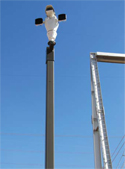
Power Accord
How one tailored system is fitting the bill for day/night surveillance in remote locations
- By Martina Panighel
- Dec 01, 2010
With temperatures regularly topping 100 degrees
Fahrenheit in the Southwestern state of Arizona,
residents need a reliable source of electricity
to run air conditioners. Power utility APS is
the Grand Canyon State’s largest electric utility
and Arizona’s leading producer of electric power, providing reliable
power with quality service at a reasonable cost for more than 100
years. APS, which is owned by Pinnacle West Capital Corp., serves
more than 1.1 million customers in 11 of the 15 counties in the state.
The Challenge
APS has found that it needs to monitor its critical infrastructure and
substations, which are located all over the state. Much of the infrastructure
is located in areas that are often difficult to reach, such as its
Palo Verde nuclear power-generating station, located about 55 miles
west of Phoenix, which has been the largest power producer of any
kind in the United States since 1992.
APS already had a video surveillance system in place equipped
with a series of thermal imaging PTZ. The problem, however, was
that this legacy system had a high failure rate and was quite costly to
maintain. Seeking an effective surveillance system for both sunny and
nighttime conditions, APS moved to Videotec’s solution, a ULISSE
positioning system specifically created for applications of day/night
video surveillance in external environments.
The Solution
Videotec’s ULISSE surveillance system has an integrated housing,
P&T head and telemetry receiver. In order to monitor its power infrastructure
around the clock, APS needed some sort of night surveillance
capabilities. So the power company’s package included two
Videotec infrared LED illuminators without external rotating cables.
ULISSE’s rotation on the horizontal axis is continuous, with a variable
speed of up to 40 degrees per second. The amplitude on the vertical
axis varies from +90 degrees to -40 degrees with a max speed of 30
degrees per second. ULISSE controls the functions of autopan and patrol
with a tracking accuracy of 0.02 degrees on preset positions recall.
The positioning system is controlled through an RS485/RS422.
Active infrared night vision like ULISSE PTZ incorporates illuminators
that produce high levels of infrared light, and the resulting
images are typically higher resolution than other night-vision technologies.
The system fit APS’s needs well.
“Working close with APS,” said Gianni Viero, vice president at
Videotec, “we offered a valuable solution with one of our state-ofthe-
art solution for effective day/night surveillance.”
The ULISSE PTZ with twin 20-degree IRBD Illuminators have
been fitted with a 1/2-inch CCD camera and a mechanical zoom lens,
which gives about 900 feet, or 275 meters, FOV in black and 1350 feet,
or 400 meters, FOV in daylight. Its integration with different cameras
and motorized zoom lens combination is straightforward thanks to
its side-opening housing and connection boards with preinstalled
BNC. The ULISSE can be integrated in several different installations,
thanks to the several integrated protocols, or in IP-based systems,
thanks to its seamless integration with most VMS. The telemetry signal
can be transmitted in an active way for chain configuration of
several ULISSE units together, and multiple communication protocols
are embedded.
APS deployed 40 of these units in 2010 to monitor APS substations,
with a typical install consisting of two to nine units, and APS
security officials are quite happy with the fact that the ULISSE system
could be tailored to fit the power company’s needs. “With Videotec’s
unit, it has allowed us to make a unit to suit our surveillance
requirements,” said Gary Couch, APS’s physical security engineer.
Now, APS can focus on providing Arizonans with electricity to
keep cool, without having to worry about failing
cameras in remote locations, because the perfect-fit
reliability of Videotec’s ULISSE surveillance system
is keeping watch, day and night.
This article originally appeared in the issue of .
About the Author
Martina Panighel is the marketing manager for Videotec SpA.